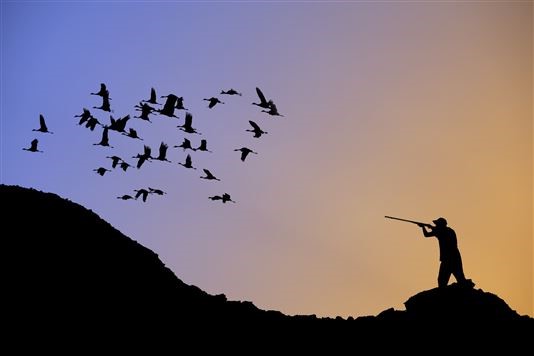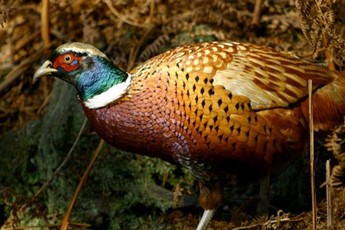Can game shooting be ethically justified?

The League Against Cruel Sports has condemned grouse shooting at the beginning of the new season.
As this year’s hunting season gets underway, the League Against Cruel Sports has been urging Michelin-starred restaurants to remove grouse from their menus.
It argues that while many restaurants now lend support to sustainable fisheries, by endorsing game bird shooting they are guilty of double standards.
This is because gamekeepers protect game birds with snares, poison and other traps, which the League says causes the death of “tens of thousands of animals each week”. As traps are indiscriminate, it argues this number includes protected species and domestic pets.
This is part of its ongoing efforts to campaign against game shooting sports.
The League also levels criticism against game farming methods and the supply of live birds from other countries. So can game shooting ever be ethical?
Lack of grouse this year

Red grouse
Hospitality industry magazine Big Hospitality reports that this year’s grouse season see a shortage of birds, and result in higher prices, due to bad weather earlier in the year.
Marks & Spencer will not be stocking red grouse this year due to the shortage, The Times has reported, and the retailer abandoned plans to stock the birds in 2014 after it was unable to get hold of “responsibly sourced” birds. But what exactly is a responsibly sourced bird? And what are the big issues with game?
Campaigning on shooting
Strong advocacy groups exist on both sides of the game hunting argument. Responding to the League’s claims regarding gamekeepers’ traps, Jack Knott of the Countryside Alliance’s Game-to-Eat campaign told loveFOOD that “the welfare of game birds is of paramount importance” and said that “recent research by DEFRA gave support to the current best practice in British game bird rearing.”

A common pheasant
Furthermore, he says that UK gamekeepers have the “highest standards for trapping in the EU” and adhere to multiple codes of best practice. “Responsible gamekeeping has no detrimental effect on species other than those specifically targeted,” he argues.
The Game-to-Eat campaign aims to increase the consumption and enjoyment of British wild game. It targets butchers, chefs, and the media in an effort to increase the popularity of game meats, and publicises the health benefits of eating these too.
For example, pheasant is a lean meat that's rich in protein and relatively low in calories when compared to poultry, while it is also a good supply of vitamins and minerals.
Free as a bird?
The Countryside Alliance describes game as “wild, natural and free range” and says that people like the fact that the meat is highly traceable. The League, on the other hand, claims that game birds are “reared in cruel conditions”. It says that laying birds are kept in intensive battery conditions that it would be illegal to keep farmed chickens in.
A DEFRA report on the farming of breeding game birds in the UK said the smallest pheasant cages in the UK offered birds 0.33m² of space each. Partridges were generally caged in male-female pairs with space of 0.2m²/bird. However, the minimum size required by law for an enriched poultry cage is just 0.075m²/bird. Cages are often raised off the ground.
A spokesperson for the Game Farmers’ Association said that no legal minimum size of cage has been set for game birds – “no doubt in part due to the variability of species, size and demeanour [of different game birds]” – and that it made sense to leave it to an expert gamekeeper, with legal protections granted to the birds by the Animal Welfare Act 2006.
“On the whole, the system seems to work very well,” it said. “Prosecutions, let alone convictions, for maltreatment of game birds are almost unheard of.” It added that hose who farm gamebirds want them to thrive and be able to fly well during the following shooting season and “it is simply not in their interests to maltreat them.”
But are there any real rules?
The League Against Cruel Sports points out that Government science advisers recommended an end to raised breeding cages in 2008.
Dr Toni Shephard, Head of Policy and Research at the League Against Cruel Sports, said that “no animal lives at this density in the wild [and] the birds have all been bitted". This is where a small metal hoop is put through the nostril to prevent them from injuring each other in captivity.

Farmed Partridges. Credit: Animal Aid, 2015
Industry standard cages, she says, also have wire mesh floors which cause painful cuts and swelling. “There is no place for the birds to shelter, and in the case of partridges barely enough room to stretch their wings.” Birds released into the wild are ill-prepared, says the League, having been fed all their lives, and many are likely to die of exposure, cannibalism, starvation or predation well before they find themselves in the crosshairs of a hunting party.
Farmed Partridges. Credit: Animal Aid, 2015
While there is a Code of Practice for keeping game birds, Dr Shephard labels this “worthless”. A Labour Code of Practice proposed before the 2010 General Election would have set minimum cage sizes “that would have effectively banned cages” she says. The Coalition Government scrapped this and introduced the current one, which she say is “frankly is a waste of space. And it is only voluntary.”

Pheasant rearing sheds. Credit: League Against Cruel Sports
Importing birds
Pheasants and partridges are shipped into the UK in large numbers from other European countries. The Farm Animal Welfare Council reported that in 2008 approximately half the pheasant stock and up to 90% of partridges for game shoots were imported.
Jack Knott of the Countryside Alliance says that this is mostly hatching eggs and day-old chicks, and that “there are no adverse welfare implications… the chicks are all shipped in line with European codes and all rearing takes place in the UK” under DEFRA rules.
Compassion in World Farming says that transporting live animals is a stressful experience that can compromise animals’ immune systems, and exhaust and dehydrate them. The spokesperson for the Game Farmers’ Association explained to loveFOOD that day-old chicks “have to be transported at a sufficiently high density not to chill. Give them too much space and they will die.”

Partridge chicks
In this case, what could look like cramped conditions are actually a necessity – although the debate about whether it is acceptable to transport live animals at all will no doubt continue.
How many birds are transported?
DEFRA estimated in 2011 that around 10 million live game birds were imported annually, which is still a significant number. It also said that there was an insufficient amount of information on the sourcing of birds, methods of transport and the training and competence of those bringing them to this country.
The League Against Cruel Sports also contends that “vast numbers of dead birds are dumped… often buried in mass graves.” But in a 2008 column for The Spectator, musician and farmer Alex James claimed that “most of the pheasants shot in this country are eaten in France”, not thrown away as others claim.
Even if this is true, it does raise a question over the efficiency of shoots. If many birds are shipped to the UK from Europe for the hunting season, in order for carcasses to be sent back to France, why are so many imported in the first place? It certainly shows that the number of birds shot far outstrips the UK’s own demand.
Is shooting acceptable?
Arguments over how game birds are reared is one thing, while the debate over shooting them is another. Inexperienced shooters may not kill a bird outright with one shot; can the suffering be justified if the bird is actually eaten?
It could be argued that a fish suffers when it is caught on a hook, and that if that fish is killed as swiftly as possible once landed, and eaten, it is justified. If the fish is dumped though that’s a different issue.
So long as birds are not just being shot for sport, and are actually being eaten, do you think shooting them is fine, or should more humane methods be used if we want to bring game to the table? And what methods would those be?
What is your opinion on game? Is its supply dependent on cruel practices, or is it acceptable? What about the effect of gamekeepers’ methods on the environment? Let us know your thoughts in the Comments below.
The League Against Cruel Sport's Inglorious Menu
The Countryside Alliance's Game-to-Eat campaign
You might also like:
Comments
Do you want to comment on this article? You need to be signed in for this feature